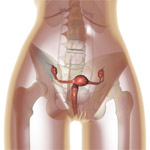 Total laparoscopic hysterectomy is removal of the uterus and cervix, all laparoscopically. Removal of the cervix is recommended for women who have had dysplasia or pre-cancer of the cervix in the past. When the cervix is removed with the body of the uterus, the precancerous cells cannot come back in the cervix. Removal of the cervix is sometimes recommended for women who have endometriosis or painful intercourse, as the cervix can be the source of pain. To remove the uterus and cervix laparoscopically, the uterus and cervix are detached from their anchors in the abdomen and pelvis. A vaginal incision is then made from the inside of the abdomen, the uterus and cervix are removed. The vaginal incision is closed laparoscopically.
Total laparoscopic hysterectomy is removal of the uterus and cervix, all laparoscopically. Removal of the cervix is recommended for women who have had dysplasia or pre-cancer of the cervix in the past. When the cervix is removed with the body of the uterus, the precancerous cells cannot come back in the cervix. Removal of the cervix is sometimes recommended for women who have endometriosis or painful intercourse, as the cervix can be the source of pain. To remove the uterus and cervix laparoscopically, the uterus and cervix are detached from their anchors in the abdomen and pelvis. A vaginal incision is then made from the inside of the abdomen, the uterus and cervix are removed. The vaginal incision is closed laparoscopically.
No actual vaginal surgery is required, the entire surgery is done laparoscopically.
Hysterectomy is a surgery to remove the uterus. Hysterectomy is done for many reasons; heavy or painful menses is the most common reason for hysterectomy. Uterine fibroids are the most common reason for having heavy painful periods. Uterine fibroids are benign muscle growths that grow in the muscle wall of the uterus. Fibroids are found in the uterus in all different sizes and locations. Fibroids cause heavy bleeding by getting in the way of the body’s ability to stop itself from bleeding once the period starts. Usually fibroids that are close to the cavity or the lining of the uterus (endometrium) are the ones that cause the heaviest bleeding. Ultrasound is the best way to diagnose fibroids and should be done anytime heavy periods are present.
Heavy painful periods can also be caused by a condition called adenomyosis. Adenomyosis is a condition where the cells from the lining of the uterus (the endometrium) instead of shedding and bleeding as a period, are misplaced into the muscle wall of the uterus. When a period happens with adenomyosis, the body’s normal way of stopping the bleeding cannot occur. Since the muscle wall of the uterus stops bleeding at the junction of the endometrium and the muscle, the muscle is not able to stop the bleeding as effectively when the glands (endometrial cells) are located inside the muscle. Adenomyosis can only be suspected prior to a hysterectomy. The only way to truly diagnose it, is to look at the uterus under a microscope once it has been removed. The symptoms of adnomyosis are heavy painful periods with a normal uterus on ultrasound.
 Voted among the "Top International Surgeons".
Elected to "Top 5% of United States Surgeons". Voted among the "Best Doctors" in Mid TN by the Nashville Business Journal.
Voted among the "Top International Surgeons".
Elected to "Top 5% of United States Surgeons". Voted among the "Best Doctors" in Mid TN by the Nashville Business Journal.